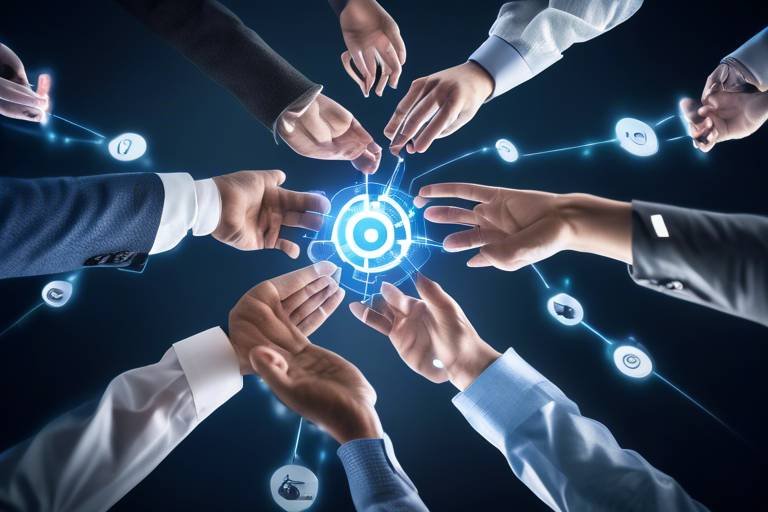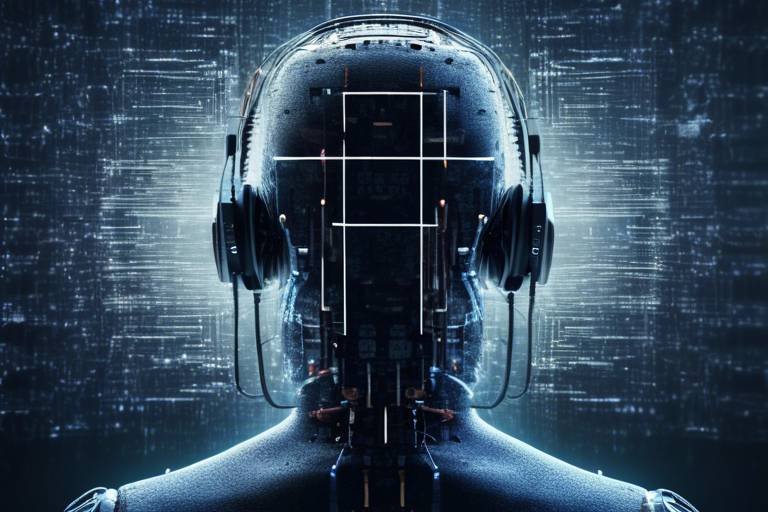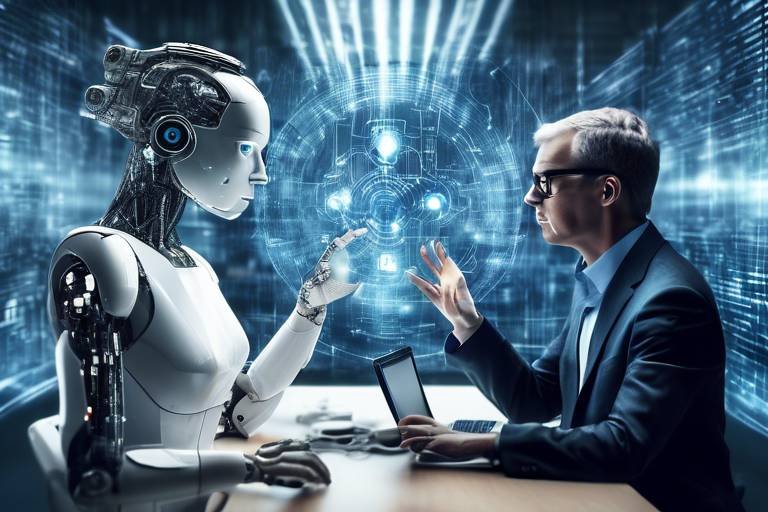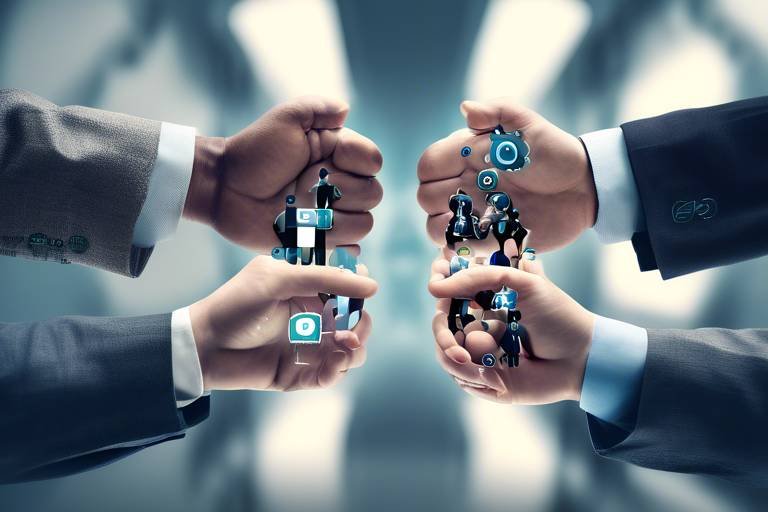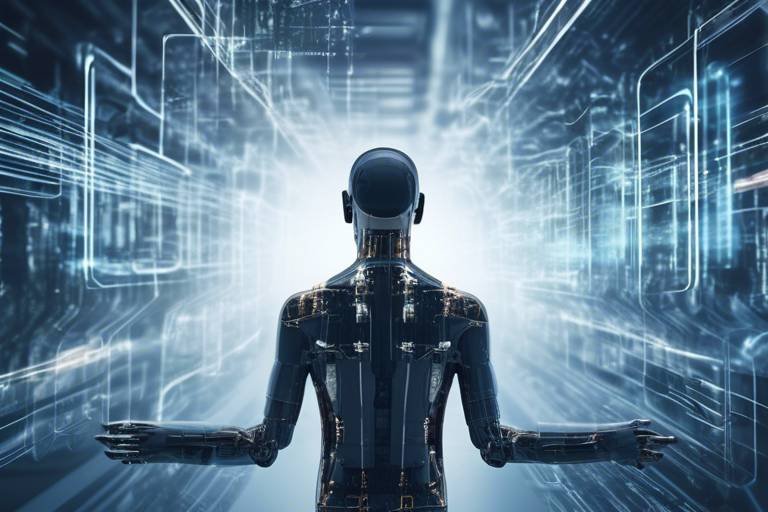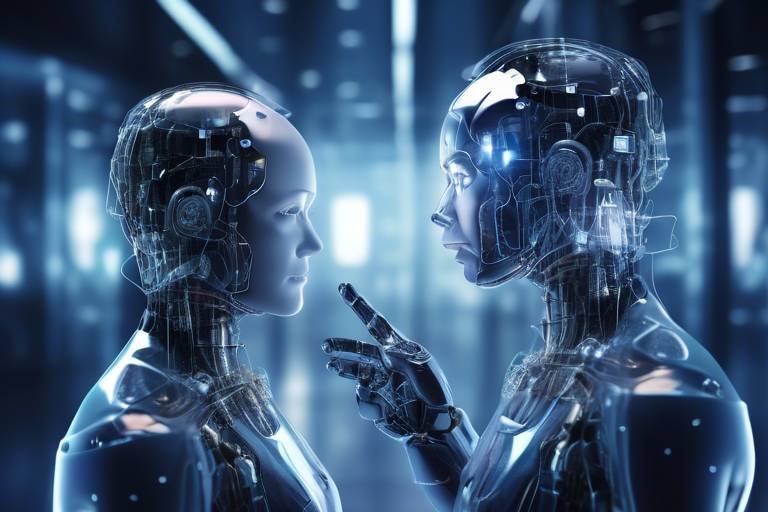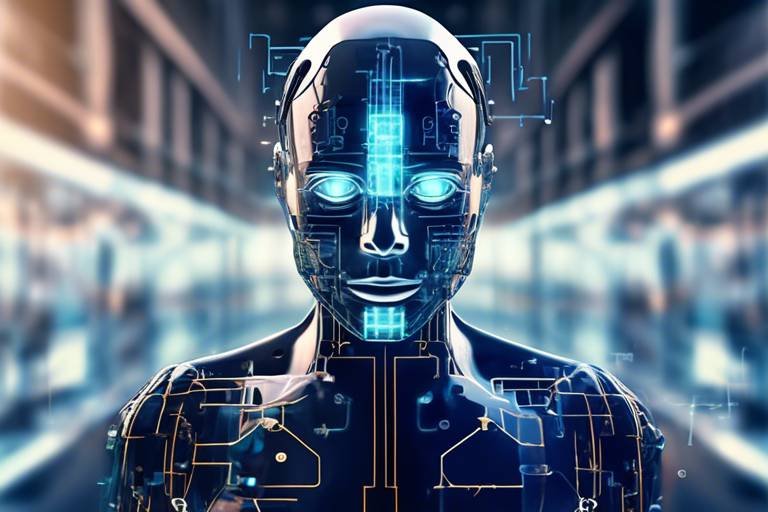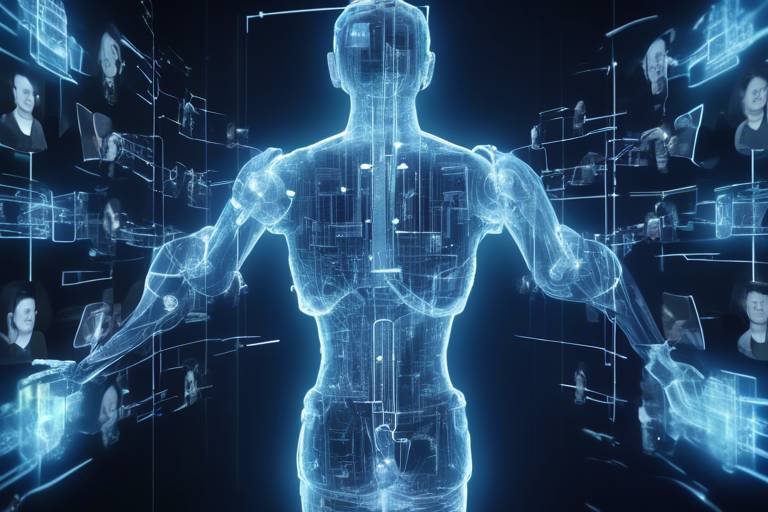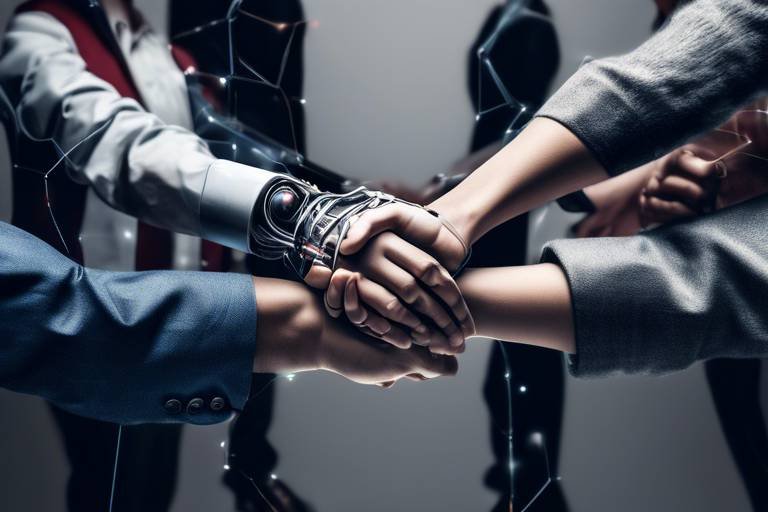Leveraging AI for Productive Human Collaboration
In today's fast-paced world, the way we collaborate and communicate in teams is undergoing a profound transformation, primarily driven by the advent of artificial intelligence (AI). Imagine a workplace where tedious tasks are automated, communication is seamless, and decisions are made with pinpoint accuracy. Sounds like a dream, right? Well, it’s becoming a reality! AI is not just a buzzword; it’s a powerful ally that can enhance teamwork, improve communication, and streamline processes. As we dive deeper into this article, we’ll explore how leveraging AI can lead to more productive human collaboration across various environments, from corporate offices to remote teams. Get ready to unlock the potential of AI and discover how it can revolutionize the way we work together!
AI tools can significantly influence team interactions by facilitating communication, providing insights, and enhancing decision-making, thereby fostering a more collaborative environment among team members. Think of AI as the glue that holds a team together; it ensures that everyone is aligned and working towards a common goal. When teams utilize AI, they can break down silos, eliminate misunderstandings, and create a culture of transparency. Imagine a team where every member has access to real-time data, insights, and support—this is the power of AI in action!
Effective communication is the cornerstone of any successful team. AI-driven communication platforms help bridge gaps in understanding, ensuring that all team members are on the same page, leading to improved collaboration and fewer misunderstandings. Picture this: you’re working on a project with a tight deadline, and a team member in a different time zone has a question. Instead of waiting hours for a reply, an AI-powered platform can provide instant answers, keeping the momentum going. This is not just about speed; it’s about creating an environment where everyone feels empowered to contribute.
Chatbots can provide immediate assistance to team members by answering queries and resolving issues, allowing for seamless collaboration without the delays typically associated with human responses. Imagine having a virtual assistant that’s available 24/7, ready to help you with anything from scheduling meetings to providing information on project status. This level of support allows teams to focus on what really matters—collaborating and innovating.
By automating routine inquiries, chatbots significantly cut down response times, enabling teams to focus on more complex tasks and fostering a more efficient collaborative atmosphere. Instead of getting bogged down by repetitive questions, team members can dedicate their time to brainstorming and executing creative solutions. This shift not only enhances productivity but also boosts team morale.
AI chatbots offer round-the-clock support, ensuring that team members can access assistance whenever needed, regardless of time zones or working hours, enhancing overall productivity. This availability means that whether it’s early morning or late at night, help is just a click away. It’s like having a team member who never sleeps, always ready to assist and keep projects on track.
AI tools analyze vast amounts of data to provide actionable insights, empowering teams to make informed decisions quickly and collaboratively, enhancing their effectiveness in achieving goals. In a world where data is king, having the right tools to sift through information can make all the difference. Imagine being able to predict trends and outcomes based on real-time data—this is the kind of power AI brings to the table.
AI can optimize project management processes by automating scheduling, tracking progress, and allocating resources more efficiently, leading to improved collaboration and timely project completion. Gone are the days of manual tracking and endless email threads. With AI, project management becomes a breeze, allowing teams to focus on creativity and innovation rather than administrative tasks.
AI systems can analyze team members' strengths and workloads, automatically assigning tasks to the most suitable individuals, thereby enhancing efficiency and collaboration within the team. This means that the right person is always working on the right task, maximizing productivity and ensuring that everyone is playing to their strengths.
With AI-driven tools, teams can monitor project progress in real-time, allowing for immediate adjustments and fostering a collaborative approach to problem-solving and project management. Think of it as having a live scoreboard for your project—everyone can see where they stand, what needs attention, and how to move forward together.
Integrating AI into the workplace can help cultivate a culture of collaboration, where team members feel empowered to share ideas and work together effectively, driving innovation and success. When people feel connected and supported, they are more likely to contribute their best ideas and efforts. AI isn’t just a tool; it’s a catalyst for creating a vibrant and dynamic workplace culture.
- How does AI improve team collaboration?
AI enhances communication, automates routine tasks, and provides data-driven insights, allowing teams to work more efficiently and effectively. - Can AI help with remote teamwork?
Absolutely! AI tools can facilitate communication and support among remote team members, ensuring everyone stays connected and informed. - What are some examples of AI tools for collaboration?
Examples include AI-powered chatbots, project management software, and communication platforms like Slack or Microsoft Teams that integrate AI features.

The Role of AI in Team Dynamics
Artificial Intelligence (AI) is revolutionizing the way teams interact and collaborate. Imagine a world where communication flows effortlessly, insights are readily available, and decision-making is both swift and informed. This is not just a futuristic dream; it's the reality that AI is creating in team dynamics today. By leveraging AI tools, teams can enhance their interactions, leading to a more collaborative and productive environment. With AI, team members can focus more on creativity and innovation rather than getting bogged down by repetitive tasks or miscommunication.
One of the most significant impacts of AI on team dynamics is its ability to facilitate communication. With AI-driven platforms, teams can break down barriers that often hinder effective collaboration. These platforms provide a centralized space where all communications occur, ensuring that everyone is on the same page. This is especially crucial in today's global work environment, where teams may be spread across different time zones and geographical locations. By utilizing AI, teams can maintain a continuous flow of information, making it easier for members to contribute and stay engaged.
Furthermore, AI tools can analyze team interactions and provide insights that help improve collaboration. For instance, AI can identify patterns in communication, highlighting which team members are most engaged and which might need encouragement to participate more actively. This kind of analysis empowers team leaders to make informed decisions about team dynamics, fostering a more inclusive atmosphere. It’s akin to having a personal coach who provides feedback on how to enhance teamwork and collaboration.
Additionally, AI can enhance decision-making processes within teams. By providing data-driven insights, AI allows teams to make informed choices quickly. This capability is vital in fast-paced environments where time is of the essence. Instead of deliberating for hours or days, teams can rely on AI to present relevant data, enabling them to reach conclusions faster. Imagine having a powerful assistant who can sift through mountains of information and present only what matters most to your team's objectives.
In summary, the role of AI in team dynamics is transformative. It streamlines communication, offers valuable insights, and enhances decision-making, all of which contribute to a more collaborative and effective working environment. As teams continue to integrate AI into their workflows, we can expect to see even greater improvements in how they collaborate, innovate, and achieve their goals.

Enhancing Communication with AI
In today’s fast-paced work environment, effective communication is the backbone of any successful team. With the advent of artificial intelligence, we are witnessing a revolution in how teams connect and collaborate. AI-driven communication platforms are transforming the traditional communication landscape, ensuring that every team member is not just heard but understood. Imagine a world where misunderstandings are minimized, and clarity reigns supreme—this is what AI brings to the table.
AI tools can analyze communication patterns and provide insights that help teams identify potential pitfalls before they escalate. For instance, AI can highlight recurring issues in team discussions, enabling proactive measures to address them. By fostering an environment where feedback is timely and constructive, teams can enhance their collaborative efforts significantly.
One of the most exciting applications of AI in communication is the deployment of chatbots. These intelligent assistants can provide immediate support to team members, answering queries and resolving issues in real-time. Imagine working late at night and needing a quick answer to a pressing question—AI chatbots are there to save the day! They eliminate the delays that often come with human responses, allowing teams to maintain their momentum.
By automating routine inquiries, chatbots significantly cut down response times. This efficiency allows team members to concentrate on more complex tasks that require human ingenuity and creativity. Think of chatbots as the unsung heroes of the workplace, tirelessly working behind the scenes to ensure that communication flows smoothly. When team members can get quick answers, they are empowered to move forward with their tasks without unnecessary interruptions.
Another remarkable feature of AI chatbots is their round-the-clock availability. Regardless of where your team members are located or what time it is, these digital assistants are always ready to help. This constant accessibility is particularly beneficial for teams spread across different time zones. Whether it’s a quick clarification or a detailed explanation, chatbots ensure that support is just a click away, enhancing overall productivity and collaboration.
In addition to chatbots, AI can also facilitate communication through advanced analytics tools that track and analyze conversations. These tools can provide insights into team dynamics, helping identify who communicates effectively and who may need additional support. By leveraging such data, teams can foster a more inclusive environment where everyone feels valued and engaged.
Moreover, AI can help in organizing information and ensuring that important discussions are easily accessible. Imagine having a digital assistant that can summarize meetings and highlight key points for you. This not only saves time but also ensures that everyone is on the same page, boosting overall team morale and productivity.
In conclusion, enhancing communication with AI is not just about introducing new tools; it’s about transforming the way we collaborate. By breaking down barriers and facilitating clearer communication, AI empowers teams to work more effectively together. The potential for innovation and success is limitless when teams harness the power of AI to enhance their communication strategies.
- How can AI improve team communication? AI can streamline communication by providing instant support through chatbots, analyzing conversation patterns, and ensuring that all team members are informed and engaged.
- Are chatbots effective in reducing response times? Yes, chatbots can handle routine inquiries quickly, allowing team members to focus on more complex tasks and enhancing overall efficiency.
- What are the benefits of 24/7 chatbot availability? Round-the-clock chatbot availability ensures that team members can access assistance anytime, which is particularly beneficial for teams working across different time zones.

AI-Powered Chatbots for Instant Support
In today's fast-paced work environment, instant support is not just a luxury; it's a necessity. This is where AI-powered chatbots come into play, revolutionizing the way teams interact and collaborate. Imagine having a virtual assistant that never sleeps, always ready to tackle queries and resolve issues at a moment's notice. These chatbots are designed to provide immediate assistance, ensuring that team members can focus on their core tasks without getting bogged down by routine inquiries.
One of the most impressive features of AI chatbots is their ability to handle a multitude of requests simultaneously. This means that while one team member is asking for data, another can be troubleshooting an issue, and yet another can be seeking clarification on a project—all at the same time! This level of responsiveness not only enhances productivity but also fosters a sense of teamwork, as everyone knows they can get the help they need without delay.
Moreover, these chatbots are equipped with advanced natural language processing capabilities, allowing them to understand and interpret human language with remarkable accuracy. This means that team members don't have to navigate through complicated menus or jargon; they can simply ask questions in a conversational tone. For example, a team member might say, "Can you help me find the latest sales report?" and the chatbot will quickly pull up the relevant document, saving precious time and effort.
To illustrate the benefits of AI-powered chatbots, consider the following table that highlights their key advantages:
| Feature | Benefit |
|---|---|
| Instant Response | Reduces wait times for team members, allowing for faster decision-making. |
| 24/7 Availability | Ensures that support is always accessible, regardless of time zones. |
| Task Automation | Handles routine inquiries, freeing up human resources for more complex tasks. |
| Scalability | Can manage increasing volumes of inquiries without additional costs. |
In addition to these features, AI chatbots also provide valuable insights into team interactions. By analyzing the types of questions asked and the frequency of requests, organizations can identify common pain points and areas for improvement. This data-driven approach enables teams to adapt and refine their processes, ultimately leading to a more cohesive and effective working environment.
In summary, AI-powered chatbots are a game-changer for instant support within teams. They not only enhance communication but also empower team members to work more efficiently and collaboratively. With the ability to provide immediate assistance, automate routine tasks, and offer valuable insights, these virtual assistants are paving the way for a more productive and connected workforce.
- What are AI-powered chatbots? - AI-powered chatbots are automated tools that use artificial intelligence to interact with users, providing instant support and assistance.
- How do chatbots improve team collaboration? - By providing immediate answers to queries, chatbots reduce response times and allow team members to focus on more complex tasks.
- Can chatbots work 24/7? - Yes, one of the key advantages of chatbots is their ability to provide round-the-clock support, regardless of time zones.
- Are chatbots capable of understanding natural language? - Absolutely! Modern chatbots are equipped with advanced natural language processing capabilities, allowing them to understand and respond to queries in a conversational manner.

Reducing Response Times
In today's fast-paced work environment, response time can make or break a team's productivity. Imagine you're in the middle of a crucial project, and you need an answer to a simple question. If you have to wait hours or even days for a response, that can lead to frustration, missed deadlines, and stalled progress. This is where AI-driven chatbots come into play, revolutionizing how teams communicate and collaborate.
By automating routine inquiries, AI chatbots can provide instant responses to common questions. This means that team members spend less time waiting for answers and more time focusing on what truly matters—achieving their goals. For instance, a chatbot can quickly handle queries like:
- What is the status of the project?
- Who is responsible for the next task?
- What are the deadlines for our current projects?
When these questions can be answered in real time, team members can make quicker decisions and keep the momentum going. The result? A more dynamic and responsive team environment where everyone feels empowered to contribute.
Moreover, AI chatbots are designed to learn from interactions, meaning they continuously improve their responses over time. They can identify frequently asked questions and provide more accurate answers, which further reduces the need for team members to reach out for help. This creates a self-sustaining cycle of efficiency that enhances overall collaboration.
Additionally, consider the impact of 24/7 availability. In a globalized workforce, team members may be spread across different time zones. AI chatbots operate around the clock, ensuring that no matter when a question arises, help is just a click away. This accessibility eliminates downtime and keeps projects moving forward, allowing teams to collaborate seamlessly across borders and schedules.
By reducing response times, AI not only enhances individual productivity but also fosters a culture of collaboration where team members feel supported and connected. When everyone can get the information they need without delay, it cultivates an atmosphere of trust and teamwork, which is essential for any successful organization.
- How do AI chatbots work? AI chatbots utilize natural language processing (NLP) to understand and respond to user queries in real time.
- Can AI chatbots handle complex inquiries? While they excel at routine questions, chatbots can also escalate complex issues to a human representative if needed.
- What are the benefits of using AI in collaboration? AI enhances communication, reduces response times, and streamlines processes, leading to more productive teamwork.

24/7 Availability
In today's fast-paced work environment, having constant access to support is essential. AI chatbots provide just that, offering round-the-clock assistance to team members, no matter where they are in the world. Imagine working late at night on a crucial project and suddenly encountering a roadblock. Instead of waiting until morning to get help from a colleague, you can simply interact with an AI chatbot that is always ready to lend a hand. This immediate access to information and support can significantly reduce downtime and keep projects moving forward.
Furthermore, the global nature of many teams today means that members often work across various time zones. AI chatbots ensure that whether it’s midday in New York or midnight in Tokyo, someone is always available to assist. This helps maintain momentum, allowing teams to collaborate effectively without the delays that can occur when relying solely on human support. It’s like having a personal assistant that never sleeps, ready to tackle inquiries and provide solutions at a moment’s notice.
To illustrate the impact of AI chatbots on availability, consider the following benefits:
- Immediate Responses: Chatbots can answer frequently asked questions instantly, allowing team members to resolve issues without waiting for a human response.
- Consistent Support: AI provides uniform responses, ensuring that all team members receive the same information, reducing confusion.
- Scalability: As teams grow, chatbots can handle an increasing number of inquiries without additional resources, maintaining efficiency.
In essence, the of AI chatbots not only enhances individual productivity but also strengthens team dynamics by ensuring that everyone has the support they need when they need it. This leads to a more collaborative and efficient work environment, where challenges can be addressed in real-time, paving the way for innovative solutions and successful outcomes.

Data-Driven Decision Making
In today's fast-paced work environment, making decisions based on solid data is not just a luxury; it's a necessity. AI tools have revolutionized the way teams approach decision-making, providing them with the ability to analyze vast amounts of information swiftly and accurately. Imagine sifting through mountains of data manually—it's like searching for a needle in a haystack! But with AI, that needle becomes glaringly obvious. This technology empowers teams to draw actionable insights from data, ensuring that every decision is informed and strategic.
When teams utilize AI for data analysis, they can uncover patterns and trends that might otherwise go unnoticed. For instance, consider a marketing team launching a new product. By leveraging AI, they can analyze customer behavior data, social media trends, and sales figures to determine the most effective strategies for their launch. This not only saves time but also enhances the quality of their decisions, enabling them to target their efforts more effectively.
Furthermore, AI tools can facilitate collaborative decision-making by providing a shared platform where team members can access the same data insights. This transparency fosters an environment where everyone can contribute their perspectives, leading to richer discussions and better outcomes. It's as if everyone is reading from the same playbook, which is crucial for cohesive teamwork.
To illustrate the impact of data-driven decision-making, here's a simple table showcasing how AI can influence different aspects of decision-making in a team setting:
| Aspect | Traditional Method | AI-Driven Approach |
|---|---|---|
| Data Analysis | Manual, time-consuming | Fast, automated insights |
| Collaboration | Isolated inputs | Shared insights for collective input |
| Decision Quality | Intuition-based | Evidence-based |
In conclusion, integrating AI into the decision-making process not only enhances the speed and accuracy of decisions but also promotes a culture of collaboration and shared responsibility. Teams that embrace this technology are not just reacting to changes but proactively shaping their strategies based on reliable data. As we continue to navigate an increasingly complex business landscape, the ability to make informed decisions will undoubtedly set successful teams apart from the rest.
- How does AI improve decision-making?
AI improves decision-making by analyzing large datasets quickly, identifying patterns, and providing actionable insights that inform strategic choices. - Can AI replace human judgment in decision-making?
No, AI is a tool that enhances human judgment. While it provides data-driven insights, the final decisions should always involve human expertise and intuition. - What types of data can AI analyze?
AI can analyze various types of data, including numerical data, text data, images, and more, making it a versatile tool for decision-making across different industries.

Streamlining Project Management
In today's fast-paced work environment, managing projects efficiently is more critical than ever. Artificial Intelligence (AI) has emerged as a game-changer in this arena, offering tools and techniques that can significantly enhance project management processes. By automating mundane tasks and providing insightful data analysis, AI not only saves time but also fosters a collaborative atmosphere where teams can thrive. Imagine having a virtual assistant that not only helps you keep track of deadlines but also understands your team's dynamics and preferences. That's the power of AI!
One of the key benefits of integrating AI into project management is its ability to automate scheduling. Traditional methods often involve endless back-and-forth emails and meetings to find a suitable time for everyone. AI can analyze team members' calendars and suggest optimal meeting times, reducing the friction that often comes with scheduling. This automation allows teams to focus more on their work rather than on logistics. Additionally, AI can track project milestones and deadlines, sending reminders to keep everyone aligned and accountable.
Moreover, AI enhances resource allocation by analyzing the strengths and workloads of team members. For instance, when a new task arises, AI can quickly assess who is available and best suited for the job based on their expertise and current workload. This not only ensures that tasks are assigned efficiently but also helps in preventing burnout among team members. The result is a more balanced distribution of work, leading to higher morale and productivity.
Real-time progress tracking is another area where AI shines. With advanced analytics, teams can monitor their project's progress at any given moment. This capability allows for immediate adjustments if any roadblocks arise. For example, if a task is falling behind schedule, AI can notify the team and suggest reallocating resources or adjusting timelines. This proactive approach fosters a collaborative problem-solving environment, where team members can quickly come together to strategize solutions.
To illustrate the impact of AI on project management, consider the following table that compares traditional project management methods with AI-enhanced approaches:
| Aspect | Traditional Methods | AI-Enhanced Methods |
|---|---|---|
| Scheduling | Manual coordination, often leading to conflicts | Automated scheduling based on availability |
| Task Assignment | Subjective assignment based on manager's judgment | Data-driven assignment based on strengths and workloads |
| Progress Tracking | Periodic updates, often reactive | Real-time monitoring and proactive adjustments |
| Communication | Emails and meetings for updates | AI-driven platforms for instant communication |
By leveraging these AI capabilities, organizations can transform their project management practices. The result is not just improved efficiency, but a more engaged and collaborative team that feels empowered to contribute their best ideas. In an age where innovation is key to success, fostering a culture of collaboration through AI integration can provide a significant competitive advantage.
Q: How does AI improve project management?
A: AI enhances project management by automating scheduling, optimizing task assignments, and providing real-time progress tracking, allowing teams to focus on collaboration and innovation.
Q: Can AI help with communication among team members?
A: Absolutely! AI-driven communication platforms facilitate seamless interactions, ensuring that all team members are informed and engaged, which reduces misunderstandings.
Q: Is AI suitable for all types of projects?
A: Yes, AI can be tailored to fit various project types and industries, making it a versatile tool for enhancing project management processes.

Automated Task Assignments
In today’s fast-paced work environment, the ability to quickly and effectively assign tasks is crucial for maintaining productivity. powered by AI are revolutionizing the way teams operate. Imagine a scenario where you no longer have to spend hours figuring out who is best suited for a specific task—AI can do that for you in a fraction of the time! By analyzing team members' strengths, previous performance, and current workloads, AI systems can make informed decisions about task allocation.
This not only streamlines the workflow but also boosts morale. When team members are assigned tasks that align with their skills and interests, they are more likely to feel engaged and motivated. For instance, if a team member excels in data analysis, the AI can prioritize them for analytical tasks, allowing them to shine in their role. This tailored approach creates a sense of ownership and accountability among team members, which is essential for fostering a collaborative atmosphere.
Moreover, consider the time saved when AI tools take over the mundane task of assignment. Instead of manually sifting through spreadsheets or emails, the AI can automatically assign tasks based on real-time data. This means that team leads can focus on strategic planning and creative problem-solving rather than getting bogged down in administrative details. The result? A more agile and responsive team that can pivot quickly in the face of challenges.
To illustrate the impact of automated task assignments, let’s take a look at a simple comparison:
| Traditional Task Assignment | Automated Task Assignment |
|---|---|
| Manual evaluation of team member strengths | AI analyzes strengths and workloads in real-time |
| Time-consuming discussions and meetings | Instant task allocation with minimal input |
| Potential for human error | Data-driven decisions reduce errors |
| Team members may feel overlooked | Tasks matched to individual skills enhance engagement |
Additionally, the integration of AI in task assignments encourages a culture of transparency. Team members can see why certain tasks are assigned to them, fostering trust in the process. When everyone understands the rationale behind task allocation, it reduces friction and promotes a collaborative spirit. In essence, automated task assignments not only enhance efficiency but also cultivate a positive team dynamic.
As we continue to embrace AI in our workplaces, it’s clear that the future of task management lies in automation. By leveraging these technologies, teams can operate more smoothly, allowing for greater innovation and collaboration. So, are you ready to let AI take your task assignments to the next level?
- What are automated task assignments? Automated task assignments use AI to allocate tasks to team members based on their strengths, workloads, and performance.
- How does AI improve task management? AI analyzes data quickly and accurately, reducing the time spent on manual evaluations and improving overall efficiency in task allocation.
- Can automated task assignments enhance team morale? Yes! When tasks align with individual strengths, team members feel more engaged and valued, which boosts morale.
- Is there a risk of over-reliance on AI for task assignments? While AI can significantly enhance efficiency, it's essential to maintain a balance and ensure that team leads remain involved in strategic decision-making.

Real-Time Progress Tracking
In today's fast-paced work environment, has become a game-changer for teams aiming to enhance their collaboration and productivity. Imagine being able to see the status of your project at any moment, just like checking the score of your favorite sports game. With AI-driven tools, this is no longer a fantasy but a reality. These systems provide teams with the ability to monitor project milestones, deadlines, and individual contributions in real-time, ensuring everyone is aligned and aware of their responsibilities.
One of the most significant advantages of real-time progress tracking is the immediate visibility it offers. Team members can quickly identify any potential bottlenecks or delays, allowing them to address issues proactively rather than reactively. This shift from a reactive to a proactive approach can drastically reduce the stress associated with last-minute scrambles to meet deadlines. For instance, if a task is falling behind schedule, the team can regroup and reallocate resources or adjust timelines accordingly.
Moreover, AI tools can generate visual dashboards that present complex data in an easily digestible format. These dashboards can include:
- Progress Bars: Visual indicators showing how much of a task has been completed.
- Gantt Charts: Illustrative timelines that detail project phases and deadlines.
- Performance Metrics: Key indicators that measure team efficiency and productivity.
By leveraging these visual aids, teams can foster a culture of transparency where everyone is aware of the project's status. This transparency not only enhances accountability but also encourages open dialogue among team members. When everyone understands where the project stands, they can engage in more meaningful discussions about how to move forward. It’s like having a map that guides you through a complex maze, ensuring that no one gets lost along the way.
Additionally, real-time tracking tools often come equipped with features that allow for instant feedback and communication. For example, if a team member completes a task, they can immediately update its status on the platform, triggering notifications to the rest of the team. This instant feedback loop keeps everyone informed and engaged, making collaboration feel more dynamic and less like a chore. It’s akin to a well-coordinated dance where each member knows their steps and timing, creating a seamless performance.
In conclusion, real-time progress tracking is not just about keeping tabs on tasks; it's about creating a collaborative environment where teams can thrive. By utilizing AI-driven tools, teams can enhance their communication, stay aligned on goals, and ultimately drive projects to successful completion. The power of knowing exactly where you stand at any given moment cannot be underestimated—it transforms the way teams work together, making collaboration not only more efficient but also more enjoyable.
- What is real-time progress tracking? - Real-time progress tracking refers to the ability to monitor the status of a project continuously, allowing teams to make informed decisions and adjustments as needed.
- How does AI enhance progress tracking? - AI enhances progress tracking by providing data analytics, visual dashboards, and instant feedback mechanisms that help teams stay aligned and informed.
- Can real-time tracking improve team collaboration? - Yes, it fosters transparency and accountability, encouraging open communication and proactive problem-solving among team members.

Building a Collaborative Culture
In today’s fast-paced work environment, fostering a collaborative culture is more essential than ever. With the integration of artificial intelligence (AI), organizations can create an atmosphere where teamwork flourishes and innovation thrives. Imagine a workplace where every idea is valued, and every team member feels empowered to contribute. This is not just a dream; it's a reality that can be achieved through the strategic use of AI. By leveraging technology to enhance communication and streamline processes, companies can cultivate a culture that encourages collaboration and creativity.
One of the most significant ways AI contributes to a collaborative culture is by breaking down silos. Traditional work environments often have departments that operate independently, leading to a lack of communication and a fragmented approach to problem-solving. However, AI tools facilitate seamless communication by providing platforms that allow team members from different departments to connect and share ideas effortlessly. This interconnectedness not only enhances productivity but also fosters a sense of belonging among team members.
Moreover, AI can help identify collaboration opportunities that might otherwise go unnoticed. For instance, AI analytics can reveal patterns in project workflows, highlighting areas where team members could collaborate more effectively. By analyzing data on team interactions, organizations can pinpoint which employees work well together and encourage those partnerships. This data-driven approach to collaboration ensures that teams are not only working together but are doing so in the most efficient manner possible.
To further enhance this collaborative culture, organizations can implement regular brainstorming sessions powered by AI tools. These sessions can utilize AI to gather insights from past projects, analyze successful strategies, and even suggest new ideas based on current trends. When team members come together to brainstorm with the support of AI, they are more likely to generate innovative solutions that can propel the organization forward.
Additionally, training and development play a crucial role in building a collaborative culture. Organizations should invest in training programs that teach employees how to use AI tools effectively. When team members are comfortable with the technology at their disposal, they are more likely to engage in collaborative efforts. Providing ongoing support and resources ensures that everyone is on the same page and can contribute meaningfully to team goals.
Finally, it’s essential to recognize and reward collaboration within the workplace. By celebrating team achievements and highlighting successful collaborative efforts, organizations can reinforce the importance of teamwork. This recognition can take many forms, from shout-outs in meetings to formal awards for outstanding collaboration. When employees see that their efforts to work together are valued, they are more likely to continue fostering a collaborative spirit.
In conclusion, building a collaborative culture is not merely about implementing AI tools; it requires a comprehensive approach that prioritizes communication, training, and recognition. By embracing these strategies, organizations can create an environment where collaboration is not just encouraged but is a fundamental part of the organizational ethos.
- What is a collaborative culture? A collaborative culture is an environment where team members work together effectively, sharing ideas and resources to achieve common goals.
- How does AI enhance collaboration? AI enhances collaboration by streamlining communication, providing insights from data, and automating routine tasks, allowing teams to focus on more complex issues.
- What are some tools to foster collaboration? Tools such as AI-driven communication platforms, project management software, and data analytics tools can significantly improve collaboration.
- Why is recognition important in a collaborative culture? Recognition reinforces positive behaviors and motivates team members to continue collaborating, fostering a more engaged and productive workforce.
Frequently Asked Questions
- How does AI enhance teamwork?
AI enhances teamwork by providing tools that facilitate communication, streamline processes, and offer insights. This leads to a more collaborative environment where team members can easily share ideas and work together towards common goals.
- What role do AI-powered chatbots play in collaboration?
AI-powered chatbots offer instant support to team members by answering queries and resolving issues quickly. This reduces delays in communication and allows teams to focus on more complex tasks, ultimately improving collaboration.
- Can AI tools improve decision-making?
Absolutely! AI tools analyze large data sets to provide actionable insights, which empowers teams to make informed decisions swiftly. This capability enhances the overall effectiveness of the team in achieving their objectives.
- How does AI streamline project management?
AI streamlines project management by automating scheduling, tracking progress, and efficiently allocating resources. This leads to timely project completion and fosters better collaboration among team members.
- What are automated task assignments?
Automated task assignments are processes where AI systems analyze the strengths and workloads of team members to assign tasks to the most suitable individuals. This enhances efficiency and collaboration within the team.
- How can AI help build a collaborative culture?
Integrating AI into the workplace encourages a culture of collaboration by empowering team members to share ideas freely and work together effectively. This drives innovation and contributes to the overall success of the organization.
- Is AI support available 24/7?
Yes! AI chatbots provide round-the-clock support, ensuring that team members can access assistance whenever they need it, regardless of time zones or working hours, which greatly enhances productivity.
- What are the benefits of real-time progress tracking?
Real-time progress tracking allows teams to monitor their project status continuously, enabling immediate adjustments and fostering a collaborative approach to problem-solving. This ensures that projects stay on track and objectives are met efficiently.

